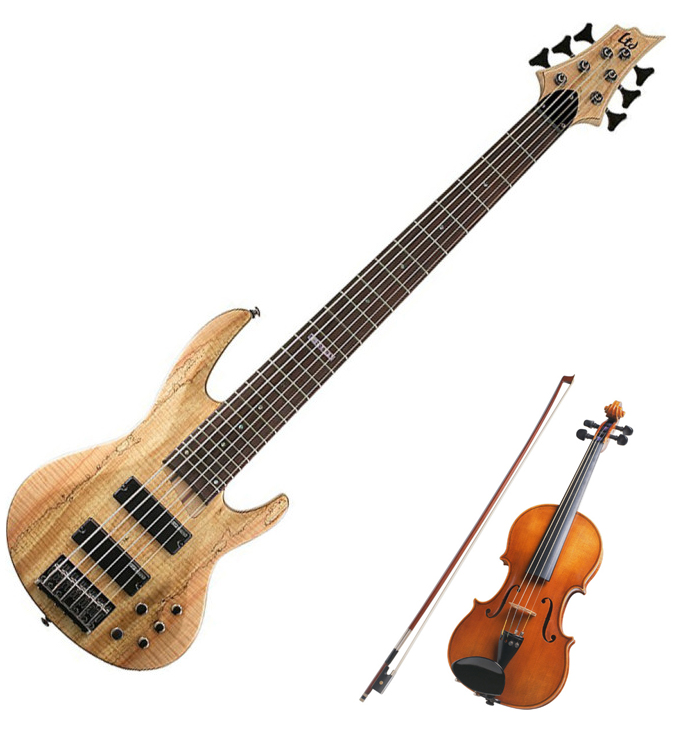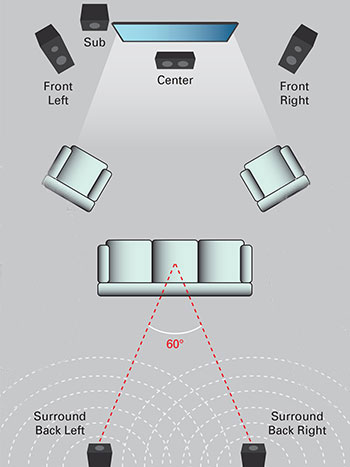How to Get More From Your Music Listening
A Professional Reveals How to Fully Experience the Joy of Music
There are few things in life better than listening to good music. The experience is right up there with orgasms, taking a good mind altering substance, falling in love or having an exciting adventure. If you do not get a significant amount of enjoyment from listening to music it may be due to that form of expression not being suited for your tastes. But since there is a HUGE quantity of quality music available for a wide variety of tastes, it is more likely you haven't been doing it right. This article is intended to help you have the best listening experiences and find the best available music.
Listening to music on a cheap AM radio is not the same as listening to music from a high quality source on a good quality sound system in an optimized environment. The AM radio may be fine for listening to an old pop song or the news, but fully perceiving and appreciating the artistry of the most skilled creators of high quality music is much easier when your playback system and environment are optimized to allows you to appreciate the finer details of the material. It is just not possible to appreciate the nuances of a highly skilled jazz drummer's brush work on a cheap AM radio while your next door neighbor is mowing the lawn.On a low quality reproduction system, it is often impossible to perceive and appreciate the differences between mediorcre works and masterpeices.
Yes, it takes some money to acquire a good audio system, but with a little knowledge you can optimize the quality of the equipment you own and select the best products for your budget.
Factors in sound quality

Frequency Response
Lower pitched sound sources such as bass guitars create mostly low frequency sounds. Higher pitched sound sources such as violins create mostly high frequency sounds. Frequency response is the ability of a sound system to accurately reproduce all frequencies (from low pitch sounds to high pitch sounds) at the same sound level across the full audible range.

Distortion
Distortion is a change to the audio signal. It is most noticeable when the sound level in a system is increased beyond the equipment's capacity to accurately reproduce the signal, resulting in a harsh sound. Distortion is usually considered undesirable, but it is routinely used as an intentional effect for electric guitars and other instruments. Most of us don't want it added to a piece of music by our sound system, but fans of tube based audio systems probably prefer tubes because they find the small amount of distortion created by the tubes to be pleasing.

Noise
Noise is unwanted sound, including the static and noise in a radio signal, record surface noise, and hiss from a magnetic tape or an amplifier. There is also noise in the listening environment that can make the quieter parts of the music less audible.

Dynamic Range
Dynamic range is a measure of the sound system's ability to accurately reproduce sound at all volume levels, from quiet sounds to loud sounds. The dynamic range is limited at low volumes by the amount of noise in the sound system and the environment. The dynamic range is limited at high volumes by the ability of the sound system to reproduce louder sounds without distortion.
The best sound systems reproduce sounds with a wide and even frequency response, have minimum distortion, low noise and a wide dynamic range. When selecting s system check the specs and use your ears to find the best systemn you can afford.
Format Matters
The format of your content matters. For best results, choose the best format.
Hierarchy of recorded media, from worst to best:
45 rpm singles
Cassette tapes
FM radio
MP3s
12" vinyl
CDs
DVDs
DVD-Audio & SACD discs, Blu-Ray
Speakers Matter
Usually, the most significant factor impacting your listening experience is the quality of the speakers. Speakers convert the electrical energy from the amplifier to acoustic energy, which is the most crucial process in a music listening system. When you buy a sound system spend much of your money on the speakers. The cabinet (enclosure) of higher quality speakers are made of dense materials such as hard woods in order to minimize unwanted resonance when the speakers produce sound. When shopping for a speaker, look for a solid cabinet and avoid speakers made of lightweight materials such as thin plastic.
Ideally, speakers are capable of accurately reproducing all frequencies (from low pitch sounds to high pitch sounds) equally well across the full audible range. Only the most expensive and larger speakers come close to this ideal, subwoofers are a way to get the lowest frequencies more affordably. We are not able to locate the origin point of low frequency sounds as well as we can with higher frequencies, so having much of the lower frequencies originating from one speaker does not distort the placement of sound in space significantly. Note that many newer (since 1980) musical styles are intended to be heard in night clubs or in cars with large low frequency speakers. Without full-frequency range speakers or a subwoofer you will not hear and feel the bass properly, and it is often the most essential element of the music.
An amplifier that is not too weak to power your speakers will need to be turned up more and the signal will be more likely to be distorted and noisy as you reach the upper end of an amp's capabilities. The good news is using a powerful amplifier or a receiver is less important these days than in was in the past because speakers are more efficient and amps are less noisy and distorted than in the past. However, it is best to have an amplifier that can power your speakers as loud as you may want without being cranked up all the way.
Speaker Location is Important
Speaker placement is important for two reasons. One is that you want the sound to travel as directly as possible from the speakers to your ears as possible. That is why you want to position your speakers at the same height as your ears will be while listening and have each speaker directed towards your ears. (see illustration)
The other reason speaker placement is important is that you want to hear the placement of sounds across the stereo field as accurately as possible. The term stereo has come to mean using two channels of sound in a recording, but this definition is more accurate: "A system of recording or reproducing sound that uses two channels, each playing a portion of the original sound in such a way as to create the illusion of locating the sound at a particular position, each offset from the other, thereby more accurately imitating the location of the original sound when the recorded or reproduced sound is heard." https://en.wiktionary.org/wiki/stereo
We have two ears so that we can locate the source of a sound in space. Creators of audio content consciously place the individual instruments in a stereo (two channel)recording on the left, right or somewhere in between. The placement of instruments is usually used to create the illusion of three dimensional sound when you listen to a recording. For example the sound of each instrument in a drum kit is usually spread between the two speakers so that the instruments seem to be spread in front of you, as if the player was actually present in the room. Proper speaker placement makes it more likely that you will hear the recording with dimensional sound as intended by its creators .

MTX Audio created this illustration of proper placement of audio and video equipment. This is a 5.1 surround sound system. Note that with a (two channel) stereo system your stereo speakers should be placed in the front left and right positions.
To enhance this illusion of dimensionality, the speakers should be identical and placed in front of you, with each one directed at one ear.
Surround sound expands on the concept of stereo sound by adding front and back speakers to the stereo field in addition to the front left and right speakers. Surround sound adds a lot of fun of to listening because it can more accurately reproduce a particular listening environment and/or allow creators to place a sound to the left or right, front and back and anywhere in between. They can even make a sound move and spin around you. This is especially effective for watching video so that the sound of the helicopter or bullets flying overhead on the screen matches the action and seems to be moving to the back of the room.
The most common surround format is called 5.1, which is supported by most TV broadcasts and streamcasts, DVDs and Blu-Rays. This type of system uses six speakers. A middle speaker is added to the standard two front speakers so that the dialogue seems to be coming from the video screen. Two rear speakers are added so that sounds can be located front and back in addition to left and right. In addition, a subwoofer (the .1 in the name) is used to reproduce the lower frequency sounds.
Optimize Your Listening Environment
To increase the dynamic range of your system, try removing any noise sources in your listening environment.
If your listening environment contains mostly hard surfaces, the sound from the speakers will bounce around the room, especially if the room has parallel walls (as most do). The resulting reverberant sound will not sound as the creators intended it and will be less clear and intelligible. Creating the optimum listening environment is an art and science that can be expensive. Recording studios and serious listeners with money use acoustic designers with measuring devices to carefully place absorption and diffusion panels in the listening room. But if you have a hard, reverberant room you can probably noticeably improve your sound by simply adding sound absorbing objects such as a soft sofa, a rug or fabric wall hangings to your room.
Stop Talking, Pay Attention and Listen!
Few people actually pay attention to the music that surrounds them everywhere. Our culture is permeated with music, yet we are not encouraged to actually listen to it with our full attention. Most listening environments are not designed to encourage close listening and much of the music fed to us by mainstream media outlets lacks the substance required for rewarding listening. Much of the music selected for retail and work environments is intentionally selected because it lacks the musical elements that grab your attention. Retail store owners and employers don't want you to be distracted from your work or shopping by interesting music.
You can get more enjoyment from music by turning it up (to the loudest level that is comfortable for you), sitting down, turning off the TV, stopping your conversations and start listening closely. Pay attention to all of the elements that go into a recorded song, including the lyrics, the melodies, the vocal delivery, the mix and arrangement of the vocals and instruments, the timbre (tone) of the instruments, the effects processing of the sounds (ie. reverb, delay, auto-tune etc.), the rhythms, the musical interactions between the players and the nature of the instrumental solos. I do not suggest this as a homework assignment to strain and train your brain, instead I
am trying to call to your attention the many elements of musical composition and performances that are available to surprise and delight you. Think of this siggestion as being akin to someone pointing out the way a red boat in the ocean is catching the light during a beautiful sunset. Paying attention to these specific musical elements is simply a way to perceive the whole picture without missing a subtle but important and delightful detail.
When you get tired of paying attention, try reading something. Reading doesn't interfere with listening as much as most other activities.
Select Music for Your Moods or Activities
Often we perceive music as being "bad" simply because it clashes with our mood or activity level at a particular time. You can get more enjoyment by selecting music that is suitable for your moods or activities. Play energetic and cheerful music for doing chores, slow and meditative music for preparing for sleep, sensuous music for sex and harder and faster music for when you want to get your body moving.
Overcome Your Fear of Music
We are instinctively inclined to be disturbed by sounds that we can not identify because our survival in the wild depends on our ability to quickly respond to an unfamiliar sound that may indicate the presence of a dangerous predator or natural phenomena (ie a lightning storm or landslide). Movies and television sound designers use this tendency to strengthen the drama of a scene. In addition to using the element of surprise in the music and sound design, movie makers also use our culture's secret language of sound to intensify the action or moods on-screen. We don't give it much thought, but over the course of our lives we learn a vocabulary of sound design elements that we associate with specific moods, settings or situations. For example, a scene at a dinner table can be transformed by a skilled sound designer from a scene of domestic tranquility to a tense and dangerous scenario by adding low pitched tones to the soundscape and by making the sound of the silverware unnaturally prominent. Iconic examples of highly effective sound design include the intensely keening violins in the Psycho murder scene and the low pitched theme that accompanies the shark in Jaws. Such scenes train us to associate certain sounds with specific moods, settings or situations. These associations can interfere with the enjoyment of music if you are not concious of them.
The best artists in all media use drama, contradiction, unease and tension to grab and hold our attention. Imagine visiting a large art museum with nothing but pretty paintings of beautiful scenery and flowers. Wouldn't you rather visit an art museum that also includes the intense landscapes of Van Gogh, scenes of war, heroes and martyrs, storms and abstractions and impressionistic scenes that require using your mind to interpret? Would you spend money to see a movie or a theatrical play about a happy family who remain perfectly comfortable and content throughout the entire story? Most of do not want to avoid all of the drama, contradiction, unease and tension that is present in the best art, it would be boring.
Yet many people make an exception for music, they are afraid of hearing unfamiliar or disturbing sounds and only listen to music that is guaranteed to be free of anything that might make them feel an unpleasant emotion. These are the folks who listen to Lite or Smooth music all the time. They only want music in their lives that functions as decoration, music akin to the arrangements of flowers and bland landscape paintings that dominate the decor of hotels, corporate offices and upscale retail establishments. This type of "art" is designed to reassure you that you are in a clean, inviting environment. It is not meant to surprise you or stimulate any conscious mental process. Relegating music to the role of an innocuous background decoration may seem comforting and safe to many people, but they are missing 75% of the enjoyment available in good music. Music has many purposes, see the article Thirteen Purposes for Music for details.
To get more out of your music listening, try abandoning the notion that music should remain in the role of comforting decoration. Instead listen with the same type of attitudes and expectations that you bring to watching a good movie. With a good movie you expect and accept that there may be uncomfortable moments of fear, uncertanty and anger mixed in with the pleasant or less dramatic moments. When watching a movie we are willing to empathize with the characters and feel their unpleasant emotions because we are capable of limiting the extent to which the drama impacts us. In other words, when a movie gets unpleasant we are able to remind ourselves that it is "only a movie" and don't let experiencing a period of discomfort while watching a movie ruin our day. We are willing and able to that because we expect to get enjoyment or other value from the overall experience, despite moments of discomfort. We understand that when considering the movie as a whole, the discomfort makes the pleasurable moments, the message of the film and its resolution more meaningful, intense and satisfying.The same is true with music.
Music with moments of drama, genuine emotions, surprising elements and artistic substance may not be suitable as sonic backgound decoration, but it is much more interesting and rewarding for closer listening. The best European Classical Music composers understood the need for dramatic tension. Yes, there are many shorter classical compositions that are "pretty" throughout and make for easy listening, but the best of the longer pieces (ie. symponies and concertos) incorporate elements of drama, contradiction, unease and tension to grab and hold our attention.
When listening to music that you find to be too unfamiliar, intense, disturbing, unpleasant or unpredictable at times, remind yourself that it is "only music" and it can not harm you. (unless it is too loud, in which case go turn it down a bit) Yes, you are conditioned to interpret certain sounds as signs of danger or unease, but you can use your conscious mind to understand and analyze that mental association. With exposure to a good variety of quality music over time you will learn to appreciate new or unusual sounds as they become familiar and you form new associations with the sounds. Remember that the unpleasant moments are just part of the drama and complexity of the greater work. If the music is good, the discomfort makes the pleasurable moments, the message or emotion evoked by the whole musical composition and its resolution more meaningful, intense and satisfying.
Listening to new, unfamiliar or unusual music does become easier and more enjoyable the more you expand the breadth and depth of your musical explorations. If you are adventurous you will find plenty of music that is not worthy of your full attenton and/or tolerance, but when you find the best stuff, discovering how special it is makes all the unpleasant parts of your quest for good music worth the effort.
Choose Your Music with Care
Most commercial pop music is intended for tweens and teens, is not intended for close listening and sounds out-dated quickly. Pop music, like mainstream broadcast television, is designed for the primary purpose of getting people to listen to commercials. There is good music to be found in all genres, but putting in a little effort to find the best examples of each style is the secret to getting the most enjoyment from listening.
A lot of people complain that there is no good music on the radio. Often this is the excuse provided by people who no longer let music into their lives in a meaningful way. Wrong! There is still exciting new music being made and there is still good music on the radio, you just need to search around a bit. The trick is to not waste your time with the commercial stations. Instead, check out your local "public," community and college radio stations. If you don't find anything locally, try listening to on-line stations. For more on this topic, see the article How to Find Good Music on San Francisco Bay Area Radio
Most music critics do not consistently highlight the highest quality music. One reason is that they are expected to focus on the latest trends in music or they will appear uncool and/or upset the record companies that give them free records and other gifts. Another problem is that music writers tend to be writers first, and music fans second. The result is that critics tend to be more interested in lyrics and the performer's back story than in analyzing the music. Music writers too often lack the understanding and vocabulary necessary to adequately describe new developments in music and audio technology and musical styles.
Critics' over-emphasis on lyrics and musician's personality has rendered them unable to appreciate significant artists whose work is primarily instrumental, while causing them to drool all over mediocre verbally-oriented artists. Of course this blind faith in the cult of personality and the never-ending quest for a "New Dylan," "New Ramones" or even a "New Madonna" is encouraged by the corporations that sell us the music since it makes their marketing efforts that much easier. For more on this topic, see the article The Problem with Rock Critics
Music magazines and websites for musicians and serious fans of specific genres are among the best guides to music. Examples include Downbeat, Jazz Times, Guitar Player, Keyboard, Song Lines and Wire. The All Music and Rough Guide books (out of print, but still available on Amazon and elsewhere) and websites are also great ways to learn about music.
If you want to play it safe, start with the artists that have been appreciated by listeners, critics and musicians for a long time. Sample the best work of the timeless greats such as Hank Williams, Patsy Cline, B.B. King, Nat King Cole, Roy Orbison, Duke Ellington or Miles Davis.
Every genre of music demands a different set of criteria for judging quality and most people won't go to the trouble to try. I make a point of investigating new music and trying to get an understanding, but quite often my first reaction to something truly innovative is negative. Since 98% of everything is crap it takes a while to find the good stuff, but I promise you that it is worth the effort.
 Back to More Content Magazine
Back to More Content Magazine
 Back to Oranj Productions Home
Page
Back to Oranj Productions Home
Page
Contact Info
All content Copyright 1993-2016 Oranj Productions.
All Rights Reserved. Commercial use, public distribution or presentation allowed with written permission only.





 Back to More Content Magazine
Back to More Content Magazine